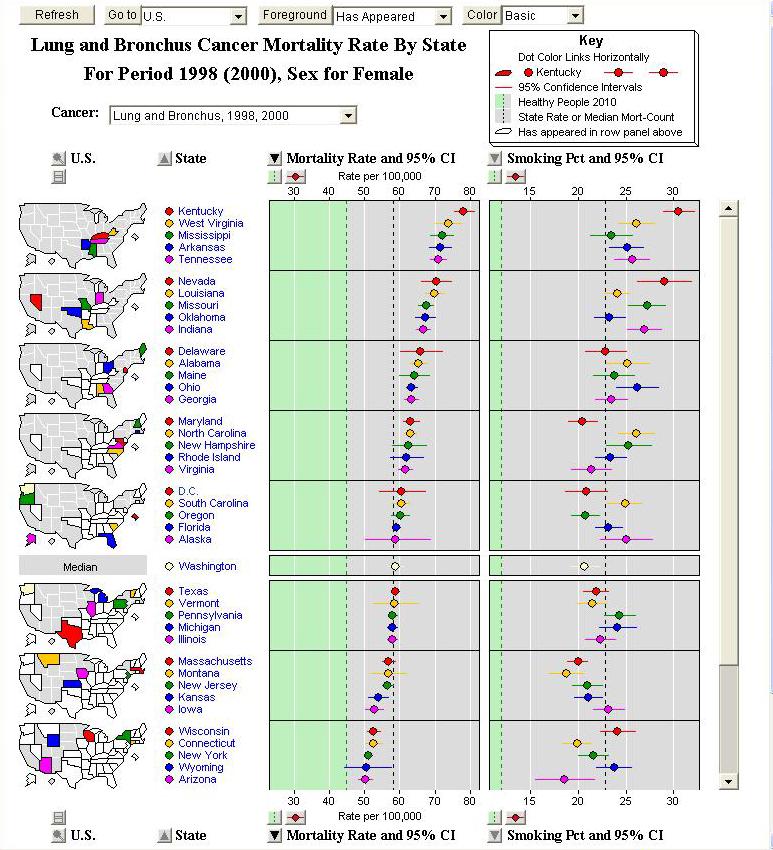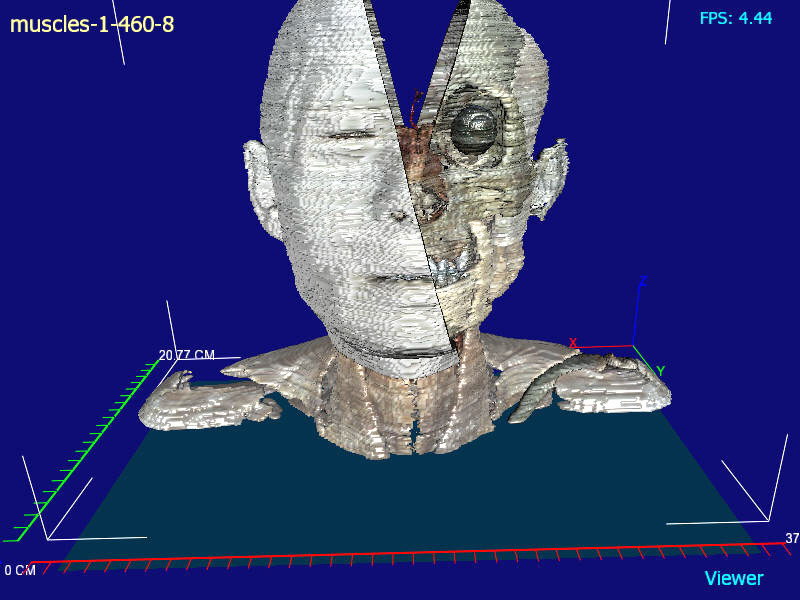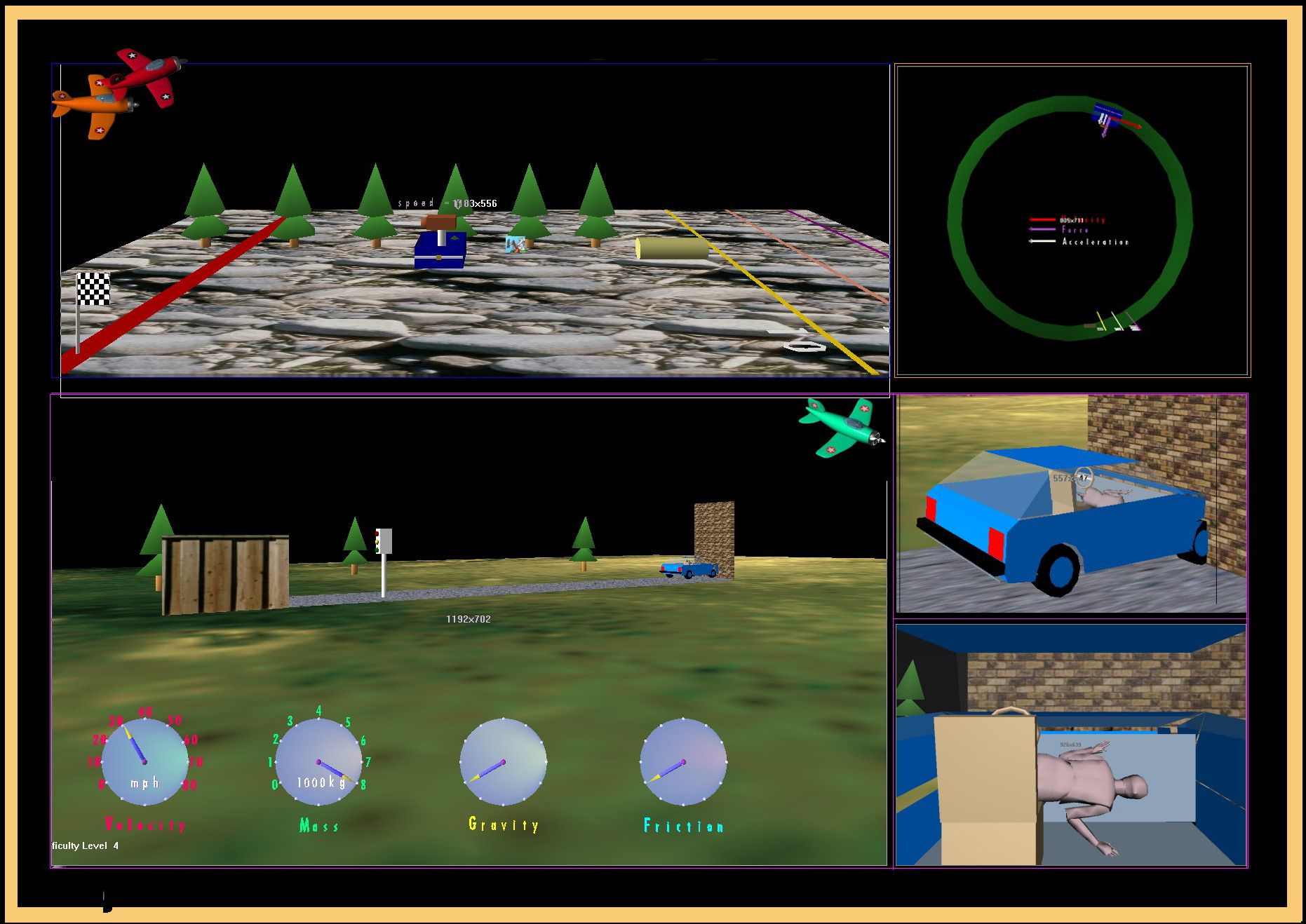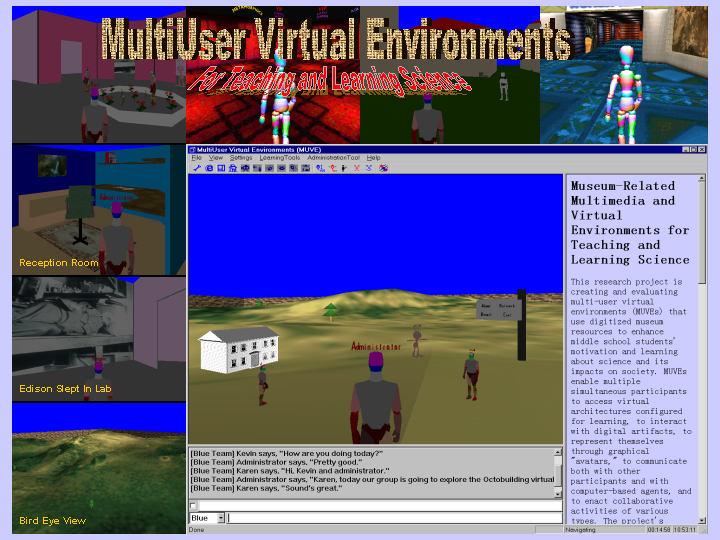
by Jim X. Chen, Daniel B. Carr, Xusheng Wang
George Mason University
Fairfax, VA 22030-4444
B. Sue Bell and Linda W. Pickle
National Cancer Institute
Bethesda, MD 20892-8317
Linked Micromap plots (LM plots) present a template for the display of spatially
indexed statistical summaries. This template has four key features [1]. First,
LM plots include at least three parallel sequences of panels (micromap, lable,
and statistical summary) that are linked by position. The second feature is
sorting the units of study. The third feature partitions the study units into
panels to focus attention on a few units at a time. The forth feature links
the highlighted study units across corresponding panels of the sequences.
LM plots represent a new visualization methodology that is useful in the data
and knowledge based pattern representation and knowledge discovery process.
It can be used to visualize various complex data in many areas [1, 2]. Interactive
LM plots can let readers clearly view and compare various relationships among
the study units.
Using LM plots to display the federal cancer statistical summaries is an effective
application. In this article, we nonetheless describe a web-based LM plots
application that is developed for the National Cancer Institute (NCI) to visualize
the cancer statistical summaries of the United States and all the states on
the Internet. These web-based LM plots not only present all the key features
of LM plots, but alsoshow the higher interactivity. Moreover, the magnified
micromap and the overall look of statistical summaries make snternet SSince
web is a public information, inventory, atusing LM plots on the web will make
more readers share this effective visualization methodology, and bring this
methodology to a more practical environment.

by Jim X. Chen, Yanling Liu, and Lin Yang
To learn human anatomy, medical students must practice on cadavers, as
must physicians when they want to brush up on their anatomy knowledge. However,
cadavers are in short supply in medical schools worldwide. Virtual anatomy
and surgery can potentially solve this problem. We present a system VHASS
(Virtual Human Anatomy and Surgery System) based on reconstructing the human
body using cryosection images. By constructing 3D models that include details
of human organs, we can give medical students and physicians unlimited access
to realistic virtual cadavers.
Currently, many systems can reconstruct the human body via magnetic resonance
imaging (MRI) or computerized tomography (CT). However, these systems have
a common drawback in that they can’t group human body components and
display human tissues in their natural colors. Consequently, technicians
have difficulty in identifying human body components clearly and must assign
artificial colors when generating 3D models from these images, which might
look good, but are unrealistic and hinder anatomy and surgery simulation
and training. Our virtual surgery system VHASS provides a better platform
for virtual anatomy because it dissects all human organs according to their
anatomic structures, separates human tissues within cryosection images,
reconstructs a 3D mesh surface for each part, and, finally, renders each
part as a high-quality 3D model, generating all parts and tissues with their
natural colors.
Reference:
L. Yang, J.X. Chen, and Y. Liu, “Virtual Human Anatomy,” IEEE
Computing in Science and Engineering, vol. 7, no.5, Sept. 2005, pp. 71-73.

by Jim X. Chen, Jingfang Wang, Xiaodong Fu, and Edward J. Wegman
(Funded by Office of the Provost at GMU; PI: Jim X. Chen)
Simulation of physically realistic complex dust behavior is very useful
in training, education, art, advertising, and entertainment. There are no
published models for real-time simulation of dust behavior generated by
a traveling vehicle. We use particle systems, computational fluid dynamics,
and behavioral simulation techniques to simulate dust behavior in real time.
First, we analyze the forces and factors that affect dust generation and
the behavior after dust particles are generated. Then, we construct physically-based
empirical models to generate dust particles and control the behavior accordingly.
We further simplify the numerical calculations by dividing dust behavior
into three stages, and establishing simplified particle system models for
each stage. We employ motion blur, particle blending, texture mapping, and
other computer graphics techniques to achieve the final results. Our contributions
include constructing physically-based empirical models to generate dust
behavior and achieving simulation of the behavior in real time.
Reference:
J.
X. Chen, X. Fu, and E. J. Wegman, "Real-Time Simulation of Dust Behaviors
Generated by a Fast Traveling Vehicle," ACM Transactions on Modeling
and Computer Simulation, Vol. 9, No. 2, April, 1999, pp.
81-104.

by Jim X. Chen and Ying Zhu
(Funded by Knee Alignment of Greater Washington, PI: Jim
X. Chen)
We use computer graphics, physics-based modeling, and interactive visualization
to assist the knee surgery study and operation. Current static examinations
of the knee such as X-rays and MRI's are replaced by interactive visualization,
surgery study, planning, exercise, and results predictions. First, a set of
magnetic resonant image (MRI) slices of the knee, the height and weight of
the patient, and other input data will be collected from the patient. Then,
a 3D knee surface model will be constructed from the MRI slices and a standard
reference knee model. After that, animations of the gait cycles will be generated
with interactive visualization of the pressure distributions at the knee joint,
which are calculated according to the current posture. At the same time, a
virtual surgery can be performed, data concerning the surgery process can
be recorded, and the simulation and visualization can demonstrate the gait
cycles and the modified pressure distributions right after the surgery.
Reference:
J.X. Chen, H. Wechsler, J.M. Pullen, Y. Zhu, E.B. MacMahon, “Knee
Surgery Assistance: Patient Model Construction, Motion Simulation, and Biomechanical
Visualization,” IEEE Transactions on Biomedical Engineering, vol.
48, no. 9, Sept. 2001, pp. 1042-1052.
Y.
Zhu, J. X. Chen, S. Xiao, and E. B. MacMahon, "3D Knee Modeling and Biomechanical
Simulation," IEEE Computing in Science and Engineering, Vol. 1, July/August,
No. 4, 1999, pp. 82-87.

by Jim X. Chen
(Funded by US Army STRICOM)
We present a new method for real-time fluid simulation in computer graphics
and dynamic virtual environments. By solving the 2D Navier-Stokes equations
using a computational fluid dynamics method, we map the surface into 3D using
the corresponding pressures in the fluid flow field. This achieves realistic
real-time fluid surface behaviors by employing the physical governing laws
of fluids but avoiding extensive 3D fluid dynamics computations. To complement
the surface behaviors, we calculate fluid volume and external boundary changes
separately to achieve full 3D general fluid flow. Unlike previous computer
graphics fluid models, our model allows multiple fluid sources to be placed
interactively at arbitrary locations in a dynamic virtual environment. The
fluid will flow from these sources at user modifiable flow rates following
a terrain which can be dynamically modified, for example, by a bulldozer.
Our approach can simulate many different fluid behaviors by changing the internal
or external boundary conditions. It can model different kinds of fluids by
varying the Reynolds number. It can simulate objects moving or floating in
fluids. It can produce synchronized general fluid flow in a distributed interactive
simulation.
Reference:
J. X. Chen, N.
V. Lobo, C. E. Hughes and J. M. Moshell, "Real-time Fluid Simulation in
a Networked Virtual Environment," IEEE Computer Graphics and Applications,
Vol. 17, No. 3, 1997, pp. 52-61.
J. X. Chen
and N. V. Lobo, "Toward Interactive-Rate Simulation of Fluids with Moving
Obstacles Using Navier-Stokes Equations," CVGIP: Graphical Models and
Image Processing, Vol. 57, No. 2, 1995, pp. 107-116.

DEVISE: Designing Environments for Virtual
Immersive Science Education
by Mike Behrmann, Jim X. Chen, Chris Dede, Debra Sprague,
Xusheng Wang, and Shuangbao Wang
(Funded by US Department of Education; PI Mike Behrmann;
Co-PI Jim X. Chen, Chris Dede)
Students with learning disabilities continue to fall behind regular
education students as they move into more cognitively competing areas, such
as science and math instruction. Immersive virtual environments can increase
access for students in regular physics education curriculum, by providing
3D abstractions, for those concepts that cannot be represented in alternative
delivery formats. The adaptability and creation of new virtual tools have
the potential to provide students with learning disabilities access to the
regular science curriculum. This project builds immersive multi-sensory virtual
learning environments that address foundations of physics instruction for
students with learning disabilities.

by Chris Dede, Jim X. Chen, Kevin Ruess, Yonggao Yang, Xusheng
Wang et al.
(Funded by NSF; PI: Chris Dede; Co-PI: Jim X. Chen, L. Fontana,
D. Allison.)
This research project is creating and evaluating multi-user virtual
environments (MUVEs) that use digitized museum resources to enhance middle
school students' motivation and learning about science and its impacts on
society. MUVEs enable multiple simultaneous participants to access virtual
architectures configured for learning, to interact with digital artifacts,
to represent themselves through graphical "avatars," to communicate both with
other participants and with computer-based agents, and to enact collaborative
activities of various types. The project's educational environments are extending
current MUVE capabilities in order to study the science learning potential
of interactive virtual museum exhibits and participatory historical situations
in science units using the NSF-funded Multimedia and Thinking Skills (MMTS)
program, an inquiry-centered curriculum engine. George Mason University's
(GMU) Computer Graphics and Virtual Reality Labs, the Division of Information
Technology and Society in the Smithsonian's National Museum of American History
(NMAH), and pilot teachers from the Gunston Middle School in Arlington, Virginia
are co-designing these MUVEs and implementing them in a variety of middle
school settings. In particular, this project is studying how the design characteristics
of these learning experiences affect students' motivation and educational
outcomes, as well as the extent to which digitized museum can aid pupils'
performance on assessments related to national science standards. This research
also is examining both the process needed to successfully implement MMTS-based
MUVEs in typical classroom settings and ways to enable strong learning outcomes
across a wide range of individual student characteristics.

by Bowen Loftin, Chris Dede, Jim X. Chen, Xusheng Wang,
et al.
(Funded by NSF)
The purpose of Project ScienceSpace is to explore the strengths
and limits of virtual reality (sensory immersion, 3-D representation) as a
medium for science education. This project is a joint research venture
among George Mason University, the University of Houston, and NASA's Johnson
Space Center. Dr. Chris Dede from Harvard University is the project Co-Principal
Investigator and Dr. R. Bowen Loftin of the University of Houston is the Principal
investigator. Dr. Jim Chen and Mr Xusheng Wang have been funded on the project
and are responsible for developing several major components for this project.







